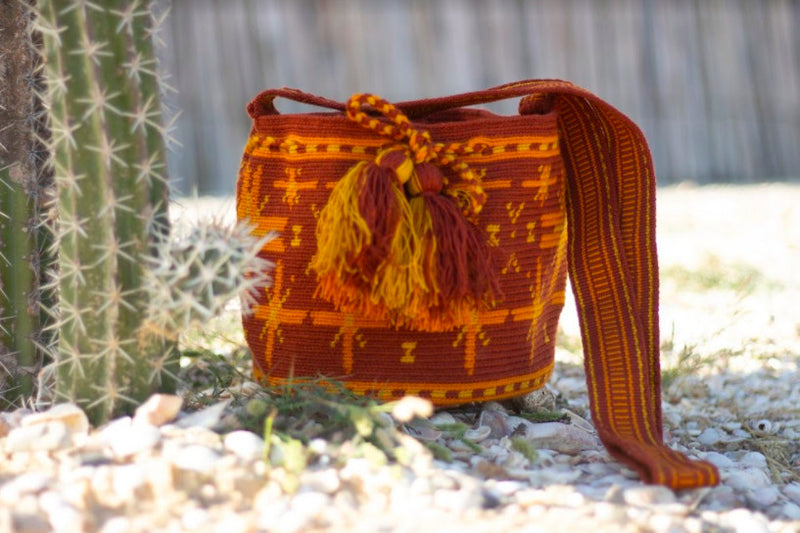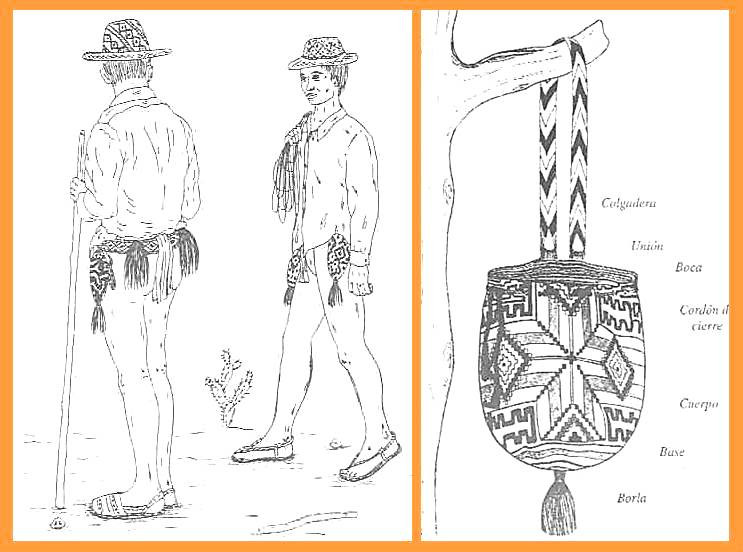
In this article we will tell you everything you need to know about Mochilas Wayúu and its importance for the survival of an entire tribe.
Wayúu bags are made 100% by hand by the Wayúu indigenous people. We can find this community in the extreme north of Colombia and part of the Venezuelan territory.
Despite living in one of the driest places in Colombia, the territory has natural resources that allow the survival of this indigenous community and that have helped them prevail since before the time of the colony.
The Wayúu bags have been an important element in the life of this community since currently the sale of these items has helped them as a livelihood to cover their pasture and cultivation needs.
However, before this, Wayúu bags were just one item of the range of elements that are part of the Wayúu weaving practices.
The art of weaving is more than a cultural practice and inheritance from their ancestors, it is a way of conceiving and expressing their life, as they feel and want it.
The legend says that Walekeru taught the Wayúu women how to weave. Walekeru is a weaver spider who always made hammocks and loops before sunrise and always had her designs and patterns ready for spring.
Wayúu bags have become very famous thanks to their colorful patterns as well as their firmness and long-lasting attributes. Through patterns and motifs, the weaver shares her cosmological vision of the universe and her traditions. For example, the techniques are passed down from generation to generation of women, which makes it one of the main traditional aspects of the indigenous community.
There are different elements that the Wayúu community weaves, among these are characterized: bags, hammocks, bracelets, and other woven creations; that have become a means of income for Wayúu women by selling them to tourists or people outside their community.
However, the article par excellence and the one most desired by nationals and foreigners are bags and here we mention the different types that exist:
Types of Mochilas Wayúu
The main types of Wayúu backpacks depend on their size, shape, colors, or usefulness. Choosing the ideal one for you will depend on how you will use it.
Susuchon bag
The Susuchon or Woot is a small bag that men usually carry on each side of the strap; forming part of the guayuco, which is the traditional male clothing garment. This backpack measures 12 to 15 cm in height, by 10 to 15 cm in width.

Susuainiakajatu
The Susuainiakajatu is a large bag used by women to carry hammocks, clothes, and other items for personal use when they travel. Wayúu women carry it on the head, due to its great weight.
Kapatera
The Kapatera is a large bag, used by men to carry clothes or hammocks when they travel or when they must travel long distances. The shape of this original Wayuu bag is a cylinder with two openings and two large closing cords.

Susu
The traditional Susu is a bag that can vary in size but is usually produced in a large size since the Wayúu uses it daily. In it, they carry items for personal use, work items, money, or other fabrics. These bags are 20 or 30 cm wide by 35 cm high. Wayúu women weave the Susu in fine cotton or acrylic yarn with various geometric designs.
Piula
Piula or Kattowi backpacks are net-shaped backpacks that are used to carry empty fruit shells or to store food or tools. They are woven with goat leather or fique fiber. Their sizes range from large narrow nets woven by hand to small narrow nets woven by the straight needle technique.

If you wonder which Wayúu bag is better, they all adapt to different needs, but for daily use, the Susus are the best option, since they can be used on any occasion. This type of bag can be found in small, medium, and large sizes, as well as in multiple designs; and in EKIITAYA we have special designs inspired by the surroundings of the Wayúu community.
Now that you are aware of the type of mochila you are more likely to use, you should know the different sizes and designs available in the market:
Susu mochila variants
Traditional mochila Wayúu
The original Wayúu bags are large and spacious. These are generally about 22x28x1cm (8.6x11x0.39 inches). It is the most used by women due to its ability to carry everything you need either for a busy day at the office or a trip to the beach. No matter what design you choose, the traditional mochila is an element that will always go very well with your outfit.
Medium mochila
Medium bags measure 19x30x1cm (7.4x11.8x0.39 inches). They are ideal for people of average height (between 1.50 and 1.70) since it looks not so big but not so small. It is also ideal for people who prefer to go light in their day-to-day activities.
Mini mochilas
The mini version of the Wayúu bag is an essential item to do small errands where you must need what you need in your bag to be able to do them without a problem.
Since this is a bag for those days when we want to carry what is necessary, the mini mochila becomes a colorful tool that allows you to have much more freedom when moving. This mochila measures 18x22x1cm (7.1x8.6x0.30 inches).
Wayuu Symbology
Wayuu weaving is rich in traditional designs called Kaanas (the art of woven design). This ancestral technique dates back to the pre-Columbian period and is embedded in different woven crafts.
According to Artesanías de Colombia, the Kanaas are geometric compositions that are repeated in the repertoire of backpacks; each one receives a name that expresses its meaning.
Even though there is a wide range of motifs for the mochilas, we can see more and more variants of designs inspired in modern society. In the case of Ekiitaya, we are still inspired by the nature and cosmovision of the Wayúu people, but we incorporate more figures that deserve to be highlighted. These geometric compositions are the butterfly, diamond, casita or little house, seawater, among others.
We invite you to know more about Ekiitaya and its Wayúu mochilas. Find your favorite and bring a little bit of La Guajira with you!
-
 Jun 08, 2021
Jun 08, 20213 Benefits of Dressing Boho Style II
In a previous article we talked about the benefits of using Boho style as part of our normal outfit.Here we will finish our benefits with others th... -
 Jun 08, 2021
Jun 08, 2021Top 3 handmade items you shouldn't miss in 2020
What are the fashionable and environmentally friendly items that are in fashion this 2020? Find the Top 3 items you should not miss this year! Ei...







